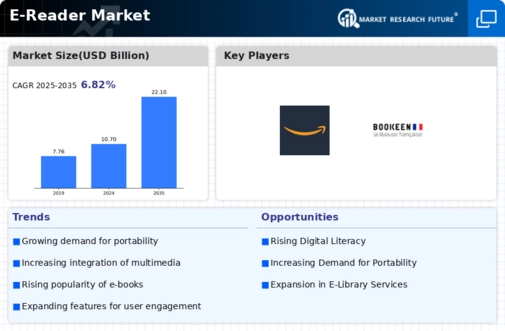Market Growth Projections
The Global E-Reader Industry is projected to experience substantial growth over the next decade. With a market valuation of 10.7 USD Billion in 2024, it is anticipated to reach 22.1 USD Billion by 2035. This growth trajectory suggests a compound annual growth rate of 6.83% from 2025 to 2035. Factors contributing to this expansion include technological advancements, increasing e-book consumption, and a growing emphasis on sustainability. The convergence of these elements indicates a robust future for the e-reader market, positioning it as a key player in the broader digital reading landscape.
Environmental Considerations
Environmental awareness is becoming a crucial factor in the Global E-Reader Industry. As consumers grow increasingly concerned about sustainability, e-readers present an eco-friendly alternative to traditional books. The production of e-readers typically results in lower carbon footprints compared to the continuous printing and distribution of physical books. This aspect appeals to environmentally conscious consumers, potentially driving market growth. Furthermore, as the industry evolves, manufacturers are likely to adopt more sustainable practices in production and packaging, aligning with global sustainability goals and enhancing the appeal of e-readers.
Growing Popularity of E-Books
The surge in e-book consumption is significantly influencing the Global E-Reader Industry. With the proliferation of e-book platforms and subscription services, readers now have unprecedented access to a vast array of titles. This trend is particularly pronounced in educational sectors, where e-books are increasingly adopted for their interactive features and cost-effectiveness. The market's growth is further supported by the fact that e-books often come at a lower price point compared to physical books, making them an attractive option for budget-conscious consumers. As e-book sales continue to rise, the demand for e-readers is expected to follow suit.
Rising Demand for Digital Reading
The Global E-Reader Industry is experiencing a notable increase in demand for digital reading solutions. As more consumers seek convenient and portable ways to access literature, e-readers have become a preferred choice. In 2024, the market is projected to reach 10.7 USD Billion, driven by the growing popularity of e-books and digital libraries. This trend is particularly evident among younger demographics who favor digital formats over traditional print. The convenience of carrying multiple titles in a single device aligns with the fast-paced lifestyle of modern readers, suggesting a sustained growth trajectory for the industry.
Technological Advancements in E-Readers
Technological innovations are playing a pivotal role in shaping the Global E-Reader Industry. Recent advancements in display technology, such as E Ink and color e-paper, enhance the reading experience by providing better visibility and reduced eye strain. Additionally, features like built-in lighting and waterproof designs cater to diverse reading environments. These enhancements not only attract new users but also encourage existing customers to upgrade their devices. As a result, the market is likely to witness a compound annual growth rate of 6.83% from 2025 to 2035, indicating a robust future driven by continuous innovation.
Expansion of Global Distribution Channels
The Global E-Reader Industry is benefiting from the expansion of distribution channels, which enhances accessibility for consumers worldwide. Online retail platforms and dedicated e-reader stores are increasingly prevalent, allowing consumers to purchase devices and e-books with ease. This accessibility is particularly important in emerging markets, where traditional retail infrastructure may be lacking. As a result, the market is poised for growth, with projections indicating a rise to 22.1 USD Billion by 2035. The diversification of sales channels not only increases consumer reach but also fosters competition among manufacturers, potentially leading to better pricing and product offerings.













Leave a Comment